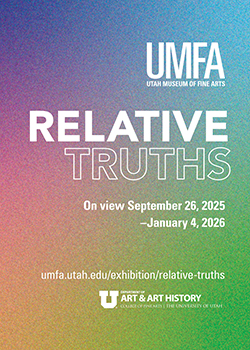
Urban Masquerade, a mural on the side of the Utah Division of Arts and Museums office building at 350 South 500 West, photo by Gerry Johnson
If Gestalt theory and art collided at an intersection, the result would surely be community art. Undeniably larger than the sum of its parts, community art emerges from its members and consciously seeks to increase the social, economic and political power of that community.
Community art’s significance is that it starts with individual contributions, but finishes as something far more cohesive and important than a collection of singular efforts. It is a conscious and cooperative effort by people in a community to work together to create art that enhances their history and improves their shared living experience.
Mural Art
V. Kim Martinez, associate professor of art at the University of Utah, has been spearheading community art projects since 2003 through the mural class she offers each fall. Martinez says her goal is to give communities a sense of ownership and pride, and to give her students experience in the bid process used for public art.
Martinez learned her mural craft from Los Angeles-based community arts pioneer Judy Baca. According to Baca’s website, the painter uses public space “to create public voice and consciousness about the presence of people who are often the majority of the population but who may not be represented in any visual way.” She also says her murals are just as much about the process of how they’re made as about end results. Baca emphasizes that a mural must be based on “the awareness that the land has memory that must be expressed” and that “art is shaped by an interactive relationship among history, people and place, marking the dignity of hidden historical precedents, restoring connections and stimulating new relationships into the future.”
Martinez incorporated Baca’s philosophy into her ART 4180 Painting/Special Topics – Murals course, which is limited to 15 students who are willing to work hard and do a lot of legwork in the community. Martinez notes that painters are “isolatory animals” who mostly use their own ideas or angst for subject matter, so students have to move out of their comfort zones in this course. “It’s difficult to make a work that’s not about you,” Martinez says, “so I really work my students hard in the beginning. Within the first month the students do a site visit, talk to community members, do research on the history of the area, and then work on an original idea for a mural. Sometimes we also do graffiti repair on previous murals so they can get the idea of physical space.”
Once the students have created their paintings, they are displayed at a community center near the targeted mural space. At that point, residents weigh in on their favorites and the votes are tallied. Once a painting is selected, it is usually altered a little to get a better perspective point, then gridded, photographed and scanned.
The next step is actually painting the mural, which Martinez insists be done right. “Flat looking murals usually get graffitied,” she says, “so we use five coats of paint to really give the mural some dimension. When people walk or drive by, we want them to notice things they didn’t notice the last time they passed it.”
“Urban Masquerade” is a recently painted mural on the eastern wall of a Utah Division of Arts and Museums office building on 500 West. The mural’s genesis was “power figure” masks made by young Youth City kids in an art class. Martinez translated the masks into a multi-faceted mural design and she and her college students, in conjunction with older Youth City participants, spent several weeks painting the mural. Martinez smiles as she remembers the event and says, “Mural painting is really a performance, like ballet. Artists are mixing paint and dancing across the scaffolding. It’s pretty amazing to watch.”
With pubic murals, there’s always the question of how long to leave them up. Some muralists insist that their work remain intact in perpetuity, but Martinez says she abides by a five-year clause in her contracts. “Communities change,” she says, “and their needs for expression may change. I’m okay with that.”
There’s also the question of money. Martinez believes artists are providing a valuable commodity and emphasizes, “I don’t think artists should work for free, so we charge about $5 per square foot for our murals, which is $3 less than the commercial rate.” After paint, scaffolding and miscellaneous costs, Martinez uses the rest of the money to take her students out of state to visit art institutions, studio spaces and other cultural centers. This year’s crew is off to Chicago, and past trips have included Wendover, New York and San Francisco. Martinez notes that these trips sometimes provide a student with a first real “aha!” art experience – one of those unique moments when one realizes Van Gogh himself actually painted this!
Martinez says there’s a mural renaissance happening in Salt Lake and she is very pleased about it. “When we first started doing murals,” she says, “we drove around in a car and looked for a building that an owner might let us use if we begged. Now they’re coming to us to ask if we’ll do a mural.” Building owners see the benefits of displaying public art, and they feel a real sense of pride in being able to connect with the community. They’re also much more willing to keep an eye on the mural and keep it cleaned up. Martinez is adamant, however, that her murals belong in the non-commercial, non-profit world. “My murals don’t sell anything,” she says resolutely.
Random Acts of Art
The Utah Division of Arts and Museums (UDAM) has recently made its own innovative strides in recognizing and embracing community art through its Change Leader network. Anna Boulton, who oversees the group, says that the Change Leader program really has a dual purpose. “It’s to help arts and culture leaders deal with continuous environmental change, and for them to be able to network and collaborate with each other.” Boulton notes that the network is especially helpful for arts and cultural leaders in rural communities because it connects them to other leaders in the state and lessens their isolation. “Really,” Boulton says, “it’s about bringing people together.”
Two years ago, at a UDAM Mountain West caucus session, participants were mulling over how the division could foster collaboration amongst communities, arts communities and businesses. There was also a conscious effort to ascertain how artists could give back to the communities that supported them. As Boulton says, “Sometimes good arts advocacy means artists helping the community meet its social needs.”
After much discussion amongst a committee of selected change leaders, the Random Acts of Art initiative was born. Designed to encourage change leaders to spearhead short-term arts projects in their communities with seed funding, the division awarded $500 to each of 10 projects ranging from Logan to Gunnison. Margaret Hunt, director of UDAM, is excited about the grants and says, “Random Acts of Art and other community-based arts projects provide an opportunity to break out of the day-to-day routine to add artistic surprises and create a community buzz. As a force for positive good, artists can build a feeling of pride in our neighborhoods and a shared sense of place.”

received her B.A. in Psychology from Lewis and Clark College, and Masters in both Social Services and Law and Social Policy from Bryn Mawr College. She is an award-winning quilt artist and the Executive Director for the Holladay Arts Council.
Categories: Organization Spotlight | Visual Arts













